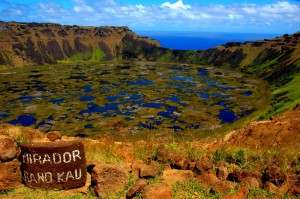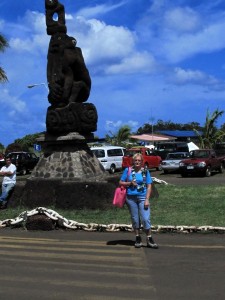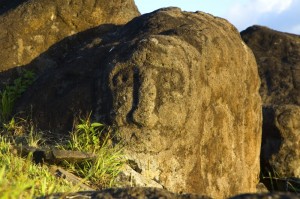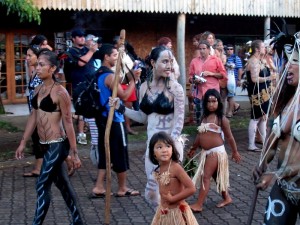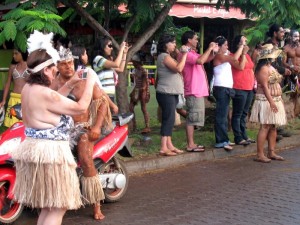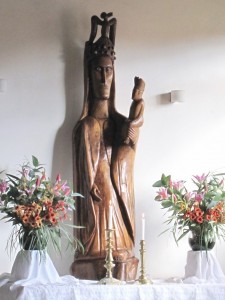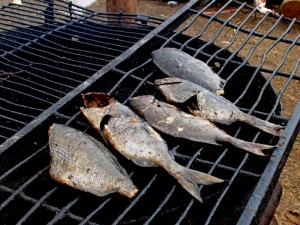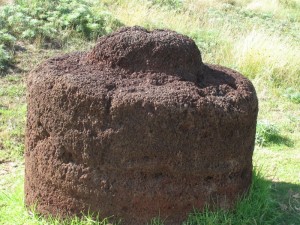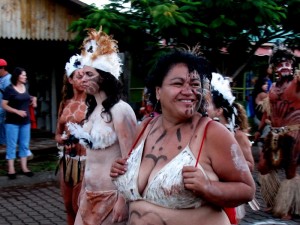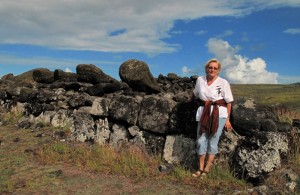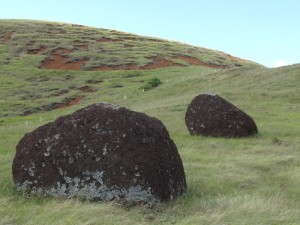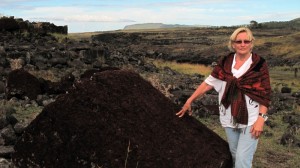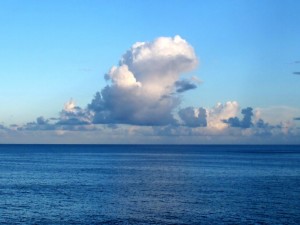balandžio 2019
VELYKŲ SALOS PASLAPTYS
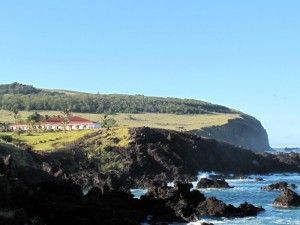 Daugelis yra skaitę norvegų keliautojo ir mokslininko T.Hejerdalo (Thor Heyerdhal) knygas apie ekspedicijas „Kon-Tikio“ir „Ra“ plaustais . Kam jos nežadino vaizduotės? Tai buvo sunkiai įsivaizduojamos kelionės, bet T. Hejerdalas įrodė, kad gana paprastu plaustu galima perplaukti vandenyną. Priplaukęs Velykų salą ir kitas salas Ramiajame vandenyne , jis įrodė, kad pirmieji žmonės į Polineziją atplaukė ne iš Azijos (kaip tvirtino dauguma mokslininkų), bet iš Amerikos.
Daugelis yra skaitę norvegų keliautojo ir mokslininko T.Hejerdalo (Thor Heyerdhal) knygas apie ekspedicijas „Kon-Tikio“ir „Ra“ plaustais . Kam jos nežadino vaizduotės? Tai buvo sunkiai įsivaizduojamos kelionės, bet T. Hejerdalas įrodė, kad gana paprastu plaustu galima perplaukti vandenyną. Priplaukęs Velykų salą ir kitas salas Ramiajame vandenyne , jis įrodė, kad pirmieji žmonės į Polineziją atplaukė ne iš Azijos (kaip tvirtino dauguma mokslininkų), bet iš Amerikos.
Velykų saloje pabuvojau ir aš. Manau, kad artėjant Velykoms bus įdomu pasiskaityti apie šią , pilną neįmintų mįslių salą, pasižiūrėti nuotraukas. T. Hejerdalas salą priplaukė plaustu, o aš- skridau iš Čilės. Tai buvo mano kelionės per visą Pietų Ameriką (nuo Ugnies žemės, per Argentiną, Braziliją, Čilę ) pabaiga. Vienintelė aviakompanija LAN-Čilė gali skraidinti keleivius į šią mažutę salą. Lėktuvai leidžiasi 1962m. amerikiečių pastatytame vieno tako oro uoste. Per dieną yra tik vienas 5 valandų skrydis iš Santjago , todėl jokios turistų spūsties saloje nėra. Nusileidimo takas eina visai šalia kranto, todėl žiūrint pro iliuminatorių atrodo, jog lėktuvas leidžiasi tiesiai į vandenį. Salą galima pasiekti laivu ar burlaiviu, bet, savaime suprantama, taip atplaukia tik pavieniai turistai.
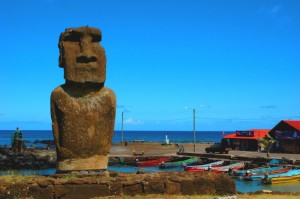 Velykų salai, arba Rapa Nui ar Te Pito O TE (kas vietos kalba reiškia pasaulio bambą arba pasaulio laivą) pavadinimą davė jūreivis olandas Jakobas Rogevenas (Jacob Roggeveen ) 1722metų Velykų rytą priplaukęs salą. Nuo 1888m. ji priklauso Čilei. Vietinių gyventojų rapanujų žemes išpirko (ar nusavino ? ) Čilės vyriausybė, kuri saloje giežtai kontroliuoja statybas, verslus, turistų srautus. Kapitonas J. Rogevenas saloje surado trijų rasių gyventojus: juodaodžius, raudonodžius ir baltuosius. Spėjama, kad pirmieji salos gyventojai atkeliavo iš Polinezijos salų ,bet T.Hejerdalo nuomone- pirmieji salos gyventojai galėjo būti amerikiečiai, nes saloje buvo auginamos saldžiosios bulvės, kurias galėjo atvežti keliautojai iš Amazonės kraštų Salos plotas tik 163 kv. km. (Tai prilygsta Kauno plotui )
Velykų salai, arba Rapa Nui ar Te Pito O TE (kas vietos kalba reiškia pasaulio bambą arba pasaulio laivą) pavadinimą davė jūreivis olandas Jakobas Rogevenas (Jacob Roggeveen ) 1722metų Velykų rytą priplaukęs salą. Nuo 1888m. ji priklauso Čilei. Vietinių gyventojų rapanujų žemes išpirko (ar nusavino ? ) Čilės vyriausybė, kuri saloje giežtai kontroliuoja statybas, verslus, turistų srautus. Kapitonas J. Rogevenas saloje surado trijų rasių gyventojus: juodaodžius, raudonodžius ir baltuosius. Spėjama, kad pirmieji salos gyventojai atkeliavo iš Polinezijos salų ,bet T.Hejerdalo nuomone- pirmieji salos gyventojai galėjo būti amerikiečiai, nes saloje buvo auginamos saldžiosios bulvės, kurias galėjo atvežti keliautojai iš Amazonės kraštų Salos plotas tik 163 kv. km. (Tai prilygsta Kauno plotui )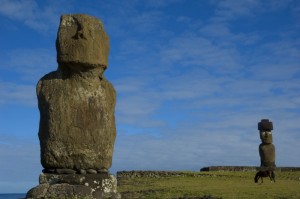 . Didžioji salos paslaptis- – akmeninės skulptūros , kurias vietiniai vadina moai. Spėjama, kad skulptūros sukurtos daugiau kaip prieš 400 metų, tačiau dar ir šiandien jos yra viena didžiausių archeologijos mįslių. Stulbina sunkiai įsivaizduojama skulptūrų didybė, energija, rimtis ir paslaptingumas.
. Didžioji salos paslaptis- – akmeninės skulptūros , kurias vietiniai vadina moai. Spėjama, kad skulptūros sukurtos daugiau kaip prieš 400 metų, tačiau dar ir šiandien jos yra viena didžiausių archeologijos mįslių. Stulbina sunkiai įsivaizduojama skulptūrų didybė, energija, rimtis ir paslaptingumas.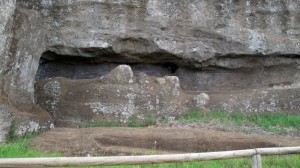 Statulos skaptuotos iš Rano Raraku ugnikalnio minkštos uolienos , dauguma jų pavienės, kitos sustatytos grupėmis ant postamentų ir visos atsuktos veidais į salą, išskyrus vieną grupę iš septynių moajų , žiūrinčią į vandenyną.
Statulos skaptuotos iš Rano Raraku ugnikalnio minkštos uolienos , dauguma jų pavienės, kitos sustatytos grupėmis ant postamentų ir visos atsuktos veidais į salą, išskyrus vieną grupę iš septynių moajų , žiūrinčią į vandenyną.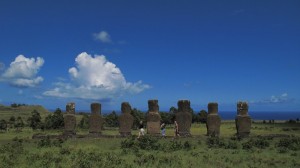 Skulptūros skirtingo dydžio: nuo pusmetrio iki 22 metrų aukščio , dauguma jų išbarstytos ant ugnikalnio ,iš kurio uolienos jos darytos, šlaitų.
Skulptūros skirtingo dydžio: nuo pusmetrio iki 22 metrų aukščio , dauguma jų išbarstytos ant ugnikalnio ,iš kurio uolienos jos darytos, šlaitų.
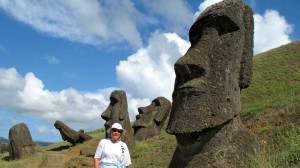 Dalis skulptūrų ant galvų turi raudono akmens galvos apdangalus, kurie tarsi primena polineziečių šukuosenas. T. Hejerdalas įrodinėjo, kad tai gali būti senųjų vikingų atvaizdai, nes tų statulų veidai europietiški, o vikingų plaukai buvę rudi.
Dalis skulptūrų ant galvų turi raudono akmens galvos apdangalus, kurie tarsi primena polineziečių šukuosenas. T. Hejerdalas įrodinėjo, kad tai gali būti senųjų vikingų atvaizdai, nes tų statulų veidai europietiški, o vikingų plaukai buvę rudi. Kepurėms gaminti raudonas akmuo buvo imamas iš kalno PUA PAO, o senąja suomių kalba „PUNA PIAJO" reiškia „ruda galva“. Gal statulos turėjo religinę paskirtį, vaizdavo genčių vadus, o gal, pagal Polinezijos papročius, įkūnijo protėvių dvasias. Prasidėjus genčių tarpusavio nesutarimams ,statulas pradėta niokoti ir griauti, galop jas nustota kalti. Šiuo metu saloje yra apie 600 geriau ar blogiau išsilaikiusių skulptūrų.1960m. pietinę salos dalį nusiaubė cunamis, vanduo paplovė kai kurias statulas ir atvėrė po jomis esančias kapavietes. Paaiškėjo, kad kai kurios skulptūros buvo ir antkapiniai paminklai.
Kepurėms gaminti raudonas akmuo buvo imamas iš kalno PUA PAO, o senąja suomių kalba „PUNA PIAJO" reiškia „ruda galva“. Gal statulos turėjo religinę paskirtį, vaizdavo genčių vadus, o gal, pagal Polinezijos papročius, įkūnijo protėvių dvasias. Prasidėjus genčių tarpusavio nesutarimams ,statulas pradėta niokoti ir griauti, galop jas nustota kalti. Šiuo metu saloje yra apie 600 geriau ar blogiau išsilaikiusių skulptūrų.1960m. pietinę salos dalį nusiaubė cunamis, vanduo paplovė kai kurias statulas ir atvėrė po jomis esančias kapavietes. Paaiškėjo, kad kai kurios skulptūros buvo ir antkapiniai paminklai.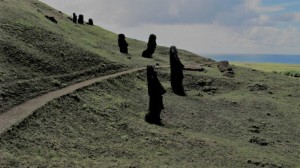
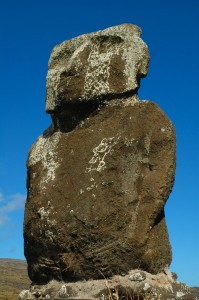
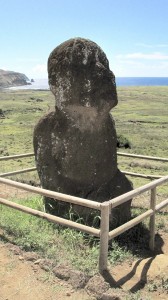
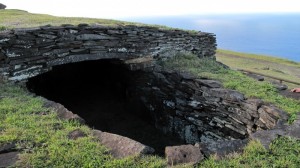
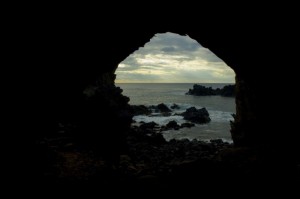 Kita salos paslaptis- požeminiai urvai, kuriuose galbūt gyveno ir slėpėsi čiabuviai. Saloje siautė europiečių atvežti raupai , kai kuriose skulptūrose išskaptuotos duobutės, panašios į raupų paliktus randus.
Kita salos paslaptis- požeminiai urvai, kuriuose galbūt gyveno ir slėpėsi čiabuviai. Saloje siautė europiečių atvežti raupai , kai kuriose skulptūrose išskaptuotos duobutės, panašios į raupų paliktus randus.
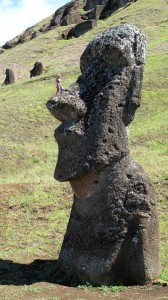 Gal urvuose buvo izoliuojami sergantieji šia užkrečiama liga ? Požemiai labai gilūs. Spėjama, kad požemiai galėjo jungti salą su žemynu. Apie tai rašė įžymusis povandeninio pasaulio tyrinėtojas Žanas Žakas Kusto. (Jacques-Yves Custeau) . T. Hejerdalo ekspedicijos nariams pavyko nusileisti į 100 metrų gylį, ten rado daugybę smulkių statulėlių, tarp jų ir gimdančios moters, kuri pagaminta iš rečiausio bazalto, randamo tik Afrikoje.
Gal urvuose buvo izoliuojami sergantieji šia užkrečiama liga ? Požemiai labai gilūs. Spėjama, kad požemiai galėjo jungti salą su žemynu. Apie tai rašė įžymusis povandeninio pasaulio tyrinėtojas Žanas Žakas Kusto. (Jacques-Yves Custeau) . T. Hejerdalo ekspedicijos nariams pavyko nusileisti į 100 metrų gylį, ten rado daugybę smulkių statulėlių, tarp jų ir gimdančios moters, kuri pagaminta iš rečiausio bazalto, randamo tik Afrikoje.
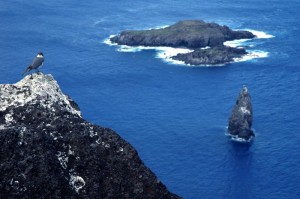 Velykų saloje, be moajų, yra dar viena įdomi apeiginė vieta. Tai vakarinėje salos dalyje esantis Orango kaimas. Senieji salos gyventojai tikėjo dievą Makė Makė. Jis sukūrė viską: saulę, vandenį, žemę, žvaigždes. Dievas atkeliavo į salą skraidančiu laivu, o pats buvęs sparnuotas. Pagrindinis šių apeigų tikslas buvo varžytuvės dėl Žmogaus- Paukščio titulo. Garbingiausi jauni genčių vyrai turėdavo nuo uolėto kranto nerti į vandenyną ir nuplaukti į netolimas tris saleles, kuriose tuo metu perėdavo juodosios jūros kregždės. Pirmasis, radęs kregždžių kiaušinį ir įteikęs jį savo vadui, tapdavo nugalėtoju. Už tai jam atitekdavo septynios gražiausios moterys, o vadas buvo tituluojamas Žmogumi- Paukščiu ir vieneriems metams tapdavo dievo Make Makės vietininku žemėje.
Velykų saloje, be moajų, yra dar viena įdomi apeiginė vieta. Tai vakarinėje salos dalyje esantis Orango kaimas. Senieji salos gyventojai tikėjo dievą Makė Makė. Jis sukūrė viską: saulę, vandenį, žemę, žvaigždes. Dievas atkeliavo į salą skraidančiu laivu, o pats buvęs sparnuotas. Pagrindinis šių apeigų tikslas buvo varžytuvės dėl Žmogaus- Paukščio titulo. Garbingiausi jauni genčių vyrai turėdavo nuo uolėto kranto nerti į vandenyną ir nuplaukti į netolimas tris saleles, kuriose tuo metu perėdavo juodosios jūros kregždės. Pirmasis, radęs kregždžių kiaušinį ir įteikęs jį savo vadui, tapdavo nugalėtoju. Už tai jam atitekdavo septynios gražiausios moterys, o vadas buvo tituluojamas Žmogumi- Paukščiu ir vieneriems metams tapdavo dievo Make Makės vietininku žemėje.
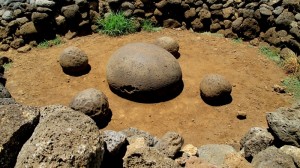 Dar viena mistinė vieta saloje- įmagnetintas akmuo, kuris saulėje įkaista iki 100 laipsnių, o keturi gretimi apvalūs akmenys , sustatyti tiksliai pagal pasaulio šalis, visai neįkaista. Ties tuo akmeniu kompaso rodyklė nepaliaujamai sukasi , o laikrodžio sekundės rodyklė visiškai sustoja. Nustatyta, kad šis akmuo saloje atsirado maždaug 500 metų anksčiau , nei buvo pastatytos pirmosios statulos. Pasakyti, kas įmagnetino ir nugludino akmenį, iki šiol nesugebėta. Velykų sala lengvai neišduoda savo paslapčių.
Dar viena mistinė vieta saloje- įmagnetintas akmuo, kuris saulėje įkaista iki 100 laipsnių, o keturi gretimi apvalūs akmenys , sustatyti tiksliai pagal pasaulio šalis, visai neįkaista. Ties tuo akmeniu kompaso rodyklė nepaliaujamai sukasi , o laikrodžio sekundės rodyklė visiškai sustoja. Nustatyta, kad šis akmuo saloje atsirado maždaug 500 metų anksčiau , nei buvo pastatytos pirmosios statulos. Pasakyti, kas įmagnetino ir nugludino akmenį, iki šiol nesugebėta. Velykų sala lengvai neišduoda savo paslapčių.
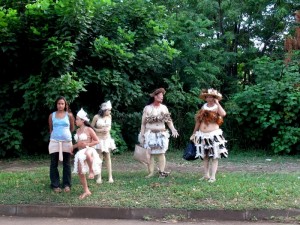
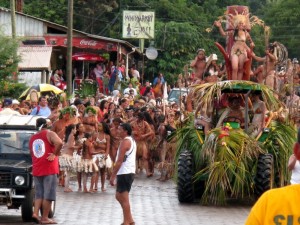

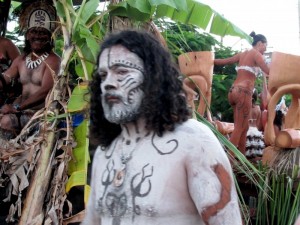
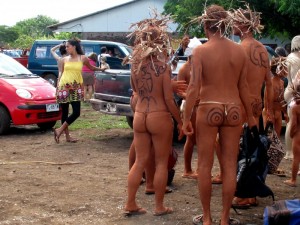 Ką veikėme saloje ? Didelių pramogų joje nėra, čia tiesiog gera būti. Mes patekome į karnavalinį laikotarpį, tai lyg mūsų Užgavėnės. Festivalis saloje vadinamas „Tapati“. Įdomu buvo stebėti smagiai nusiteikusių kaukėmis pasipuošusių ir išsidažiusių žmonių eiseną, kurioje ryškiai skyrėsi (nors vietinių papročiu irgi išsidažę) turistai. Buvo įdomu klausytis skambių melodingų dainų, stebėti ritmiškus apeiginius šokius. Šventė vyko ant vandenyno kranto. Nepaliaujama bangų mūša, susiliejusi su dainų ir šokių ritmais, dvelkė mistika ir kūrė siurrealizmo vaizdinius. Laužų šviesoje šokančiųjų šešėliai kūrė fantasmagoriškas instaliacijas. Ir mes įsiliejome į bendrą šokančią ir dainuojančią minią. Sunku buvo įsivaizduoti, kad kažkur toli yra kitas, civilizuotas pasaulis. Čia pat, ant laužų buvo kepami jaučiai, puotavo visa sala, visą naktį dundėjo būgnai , muzika, skambėjo dainos. Ir visa tai tęsėsi iki saulės patekėjimo.
Ką veikėme saloje ? Didelių pramogų joje nėra, čia tiesiog gera būti. Mes patekome į karnavalinį laikotarpį, tai lyg mūsų Užgavėnės. Festivalis saloje vadinamas „Tapati“. Įdomu buvo stebėti smagiai nusiteikusių kaukėmis pasipuošusių ir išsidažiusių žmonių eiseną, kurioje ryškiai skyrėsi (nors vietinių papročiu irgi išsidažę) turistai. Buvo įdomu klausytis skambių melodingų dainų, stebėti ritmiškus apeiginius šokius. Šventė vyko ant vandenyno kranto. Nepaliaujama bangų mūša, susiliejusi su dainų ir šokių ritmais, dvelkė mistika ir kūrė siurrealizmo vaizdinius. Laužų šviesoje šokančiųjų šešėliai kūrė fantasmagoriškas instaliacijas. Ir mes įsiliejome į bendrą šokančią ir dainuojančią minią. Sunku buvo įsivaizduoti, kad kažkur toli yra kitas, civilizuotas pasaulis. Čia pat, ant laužų buvo kepami jaučiai, puotavo visa sala, visą naktį dundėjo būgnai , muzika, skambėjo dainos. Ir visa tai tęsėsi iki saulės patekėjimo.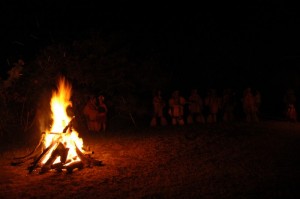
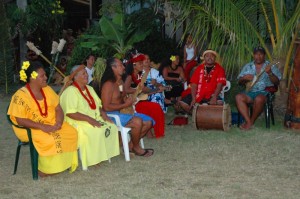
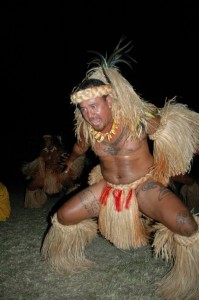
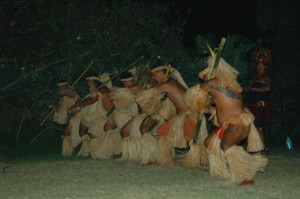
Salą galima apeiti pėsčiomis, apvažiuoti dviračiu, taipogi galima jodinėti ar mėgautis burlenčių sportu.
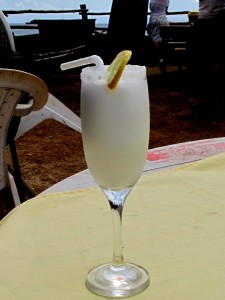
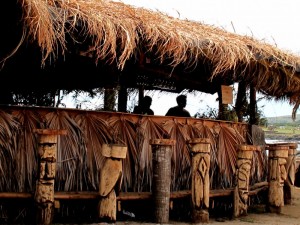 Vakarais buvo malonu sėdėti miniatiūrinėse kavinėse su vyno taure ant vandenyno kranto, klausytis nepaliaujamos vandenyno bangų mūšos į pakrantės uolas.
Vakarais buvo malonu sėdėti miniatiūrinėse kavinėse su vyno taure ant vandenyno kranto, klausytis nepaliaujamos vandenyno bangų mūšos į pakrantės uolas. 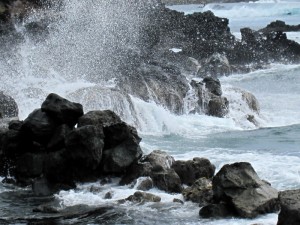
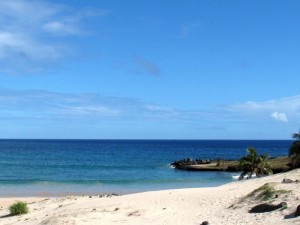
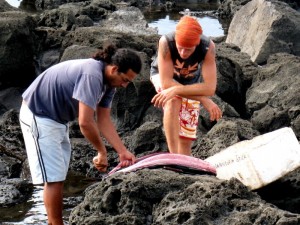
Gera buvo pasikaitinti balto smėlio paplūdimyje ir maudytis po lūžtančiomis vandenyno bangomis. Teisus buvo T. Hejerdalas , sakydamas, kad „tai, kas vienija žmoniją, yra natūralu ir turi būti skatinama, ir, priešingai, tai, kas skiria žmones yra dirbtina ir turi būti nugalėta“. Manau, kad kelionės yra didysis vienytojas - keliaudamas ne tik įgauni naujų žinių , bet ir bendrauji su skirtingų kultūrų, papročių žmonėmis. Keliaudamas pamatai, kad mus skiria tik odos spalva , buitis, gyvenimo būdas, bet ne jausmai: visur žmonės myli ir neapkenčia, tuokiasi ir skiriasi, augina vaikus ir sensta ir miršta. Mes keliaujame, nes esame apimti begalinio smalsumo bei troškimo pažinti bei suprasti seniai, seniai prieš mus buvusias civilizacijas bandydami įminti neįmenamas mįsles. Teisingai rašė prancūzų filosofas R. Descartes (Rene Descartes) „keliauti yra beveik tas pats, kas kalbėtis su praėjusių amžių žmonėmis“. 
Leonarda Šarakauskienė info@sarakauskiene.lt Toliau nuotraukos:







